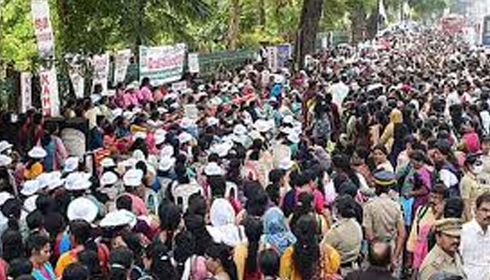
Kerala’s ASHA Workers Strike Enters Third Month: A Struggle Beyond Honorarium
On a humid February morning, a quiet protest began outside Kerala’s Secretariat in Thiruvananthapuram. Now in its third month, the sit-in led by the Kerala ASHA Health Workers Association (KAHWA) has evolved into a defining standoff between the state’s grassroots health workers and its political establishment.
The 26,448 Accredited Social Health Activists (ASHAs) currently serving the state are demanding a tripling of their monthly honorarium—from ₹7,000 to ₹21,000—immediate clearance of pending dues, retirement benefits of ₹5 lakh, and an increase in retirement age to 65. These demands echo wider struggles across India, where ASHA workers have protested in Bihar, Delhi, Odisha, and Andhra Pradesh for similar reasons: compensation that aligns with their work and social security for their future.
Kerala has long prided itself on progressive health indicators. However, the treatment of its frontline workers presents a different picture. According to data from the National Health Systems Resource Centre, Kerala saw a drop of 3,665 ASHA workers between 2020 and 2025—a reduction of nearly 12%. The decrease is not due to lower demand. The state expanded the role of Kudumbashree volunteers instead of hiring new ASHAs.
The resulting shortage has created a vacuum in health coverage, even as the workload on existing ASHAs has increased. In interviews, ASHAs say they routinely work 8–12 hours a day, with responsibilities ranging from maternal health to TB surveillance and public health data collection. Yet, they are compensated not with fixed wages but with task-based incentives, many of which are often delayed or partial.
SUCI(C), a smaller but vocal left party, is leading the current agitation, unlike previous protests. The incident has unsettled the CPI(M)-led state government and its allied trade unions, including CITU, which issued a press statement calling the protest “politically motivated”. Health Minister Veena George acknowledged the workers’ role but claimed Kerala already offers the most comprehensive ASHA benefits in India and cannot make further concessions.
Three rounds of negotiation have failed. On April 8, KAHWA submitted a fresh memorandum to Labour Minister V. Sivankutty, but the state maintained its stance—no additional compromises.
This hard line has not gone unnoticed. On International Women’s Day, the protest site witnessed a wave of support from civil society, doctors, feminist academics, and film artists. Even parliamentarians from the opposition, including Congress MP Shashi Tharoor, raised the issue in the Lok Sabha, demanding central intervention.
While the strike is state-specific, the structural faultline lies at the national level. ASHAs were conceptualised in 2005 under the National Rural Health Mission (NRHM) as community-based “activists”, not formal employees. India's labour laws still exclude them, and their income is incentive-based rather than salaried.
A 2024 study at Raipur PHC in Nagpur found that only 72% of ASHAs reported job satisfaction, citing low pay, insufficient training, and long hours. Another national study estimated that most ASHAs serve 800–1200 people each, often in challenging conditions. Despite the WHO recognising ASHAs globally, their working conditions remain precarious.
The ASHA strike in Kerala underscores a larger truth: a national health programme cannot survive on unpaid goodwill. While the workers’ honorarium has stagnated, their responsibilities have ballooned—especially post-pandemic. The state’s argument of financial constraint feels hollow when juxtaposed with its refusal to expand recruitment or explore state-level wage models.
The LDF government’s discomfort with a protest led by a non-affiliated union only highlights the politicisation of worker representation. However, ASHAs are not bargaining for ideology—they are bargaining for dignity. They are asking for stable income, recognition for their labour, and a future they can count on.
Whether the state acts now or later, one thing is clear: the current model is untenable. Without structural reforms—starting with the recognition of ASHAs as workers, not volunteers—the backbone of India’s rural healthcare will continue to splinter.